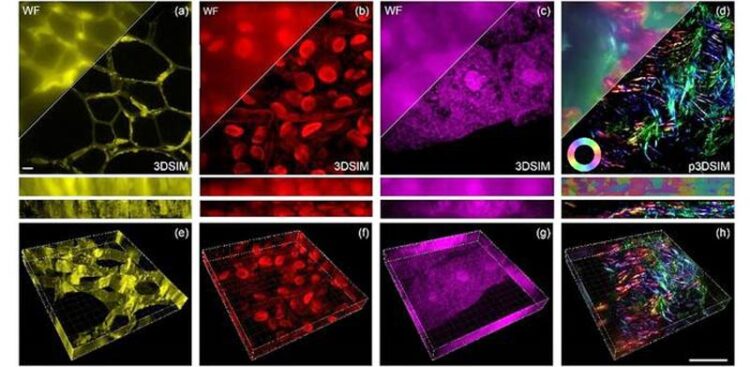Super-resolution microscopy harnesses digital display technology

Open-source core technology embedded inside projector hardware enables high-speed, auto-polarization modulated 3D structured illumination microscopy (SIM) imaging. 3DSIM reconstruction of plant and animal tissue samples: (a) cell walls in oleander leaves, (b) hollow structures within black algal leaves, (c) root tips of corn tassels, and (d) actin filaments in mouse kidney tissue; corresponding maximum intensity projection (MIP) images are shown respectively in the bottom row (e-h). Scale bar: 2 μm.
Credit: Li, Cao, et al., doi 10.1117/1.APN.3.1.016001
Microscopy breakthrough combines digital display with super-resolution for high-speed imaging to facilitate biological discovery.
In the ever-evolving realm of microscopy, recent years have witnessed remarkable strides in both hardware and algorithms, propelling our ability to explore the infinitesimal wonders of life. However, the journey towards three-dimensional structured illumination microscopy (3DSIM) has been hampered by challenges arising from the speed and intricacy of polarization modulation.
Introducing the DMD-3DSIM System
Enter the high-speed modulation 3DSIM system “DMD-3DSIM,” combining digital display with super-resolution imaging, allowing scientists to see cellular structures in unprecedented detail. As reported in Advanced Photonics Nexus, Professor Peng Xi’s team at Peking University developed this innovative setup around a digital micromirror device (DMD) and an electro-optic modulator (EOM). It tackles resolution challenges by significantly improving both lateral (side-to-side) and axial (top-to-bottom) resolution, for a 3D spatial resolution reportedly twice that achieved by traditional wide-field imaging techniques.
Polarized insight into cellular structures
In practical terms, this means DMD-3DSIM can capture intricate details of subcellular structures, such as the nuclear pore complex, microtubules, actin filaments, and mitochondria in animal cells. The system’s application was extended to study highly scattering plant cell ultrastructures, such as cell walls in oleander leaves and hollow structures in black algal leaves. Even in a mouse kidney slice, the system revealed a pronounced polarization effect in actin filaments.
An open gateway to discovery
What makes DMD-3DSIM even more exciting is a commitment to open science. Xi’s team has made all the hardware components and control mechanisms openly available on Github, fostering collaboration and encouraging the scientific community to build upon this technology.
The DMD-3DSIM technique not only facilitates significant biological discoveries but also lays the groundwork for the next generation of 3DSIM. In applications involving live cell imaging, advancements in brighter and more photostable dyes, denoising algorithms, and deep learning models based on neural networks promise to enhance imaging duration, information retrieval, and real-time restoration of 3DSIM images from noisy data. By combining hardware and software openness, the researchers hope to pave the way for the future of multidimensional imaging.
For more details, read the original Gold Open Access article by Y. Li, R. Cao, et al., “High-speed autopolarization synchronization modulation three-dimensional structured illumination microscopy,” Adv. Photon. Nexus 3(1) 016001 (2023), doi 10.1117/1.APN.3.1.016001.
Journal: Advanced Photonics Nexus
DOI: 10.1117/1.APN.3.1.016001
Article Title: High-speed autopolarization synchronization modulation three-dimensional structured illumination microscopy
Article Publication Date: 23-Dec-2023
Media Contact
Daneet Steffens
SPIE–International Society for Optics and Photonics
daneets@spie.org
Office: 360-685-5478
All latest news from the category: Physics and Astronomy
This area deals with the fundamental laws and building blocks of nature and how they interact, the properties and the behavior of matter, and research into space and time and their structures.
innovations-report provides in-depth reports and articles on subjects such as astrophysics, laser technologies, nuclear, quantum, particle and solid-state physics, nanotechnologies, planetary research and findings (Mars, Venus) and developments related to the Hubble Telescope.
Newest articles

High-energy-density aqueous battery based on halogen multi-electron transfer
Traditional non-aqueous lithium-ion batteries have a high energy density, but their safety is compromised due to the flammable organic electrolytes they utilize. Aqueous batteries use water as the solvent for…

First-ever combined heart pump and pig kidney transplant
…gives new hope to patient with terminal illness. Surgeons at NYU Langone Health performed the first-ever combined mechanical heart pump and gene-edited pig kidney transplant surgery in a 54-year-old woman…

Biophysics: Testing how well biomarkers work
LMU researchers have developed a method to determine how reliably target proteins can be labeled using super-resolution fluorescence microscopy. Modern microscopy techniques make it possible to examine the inner workings…





















